



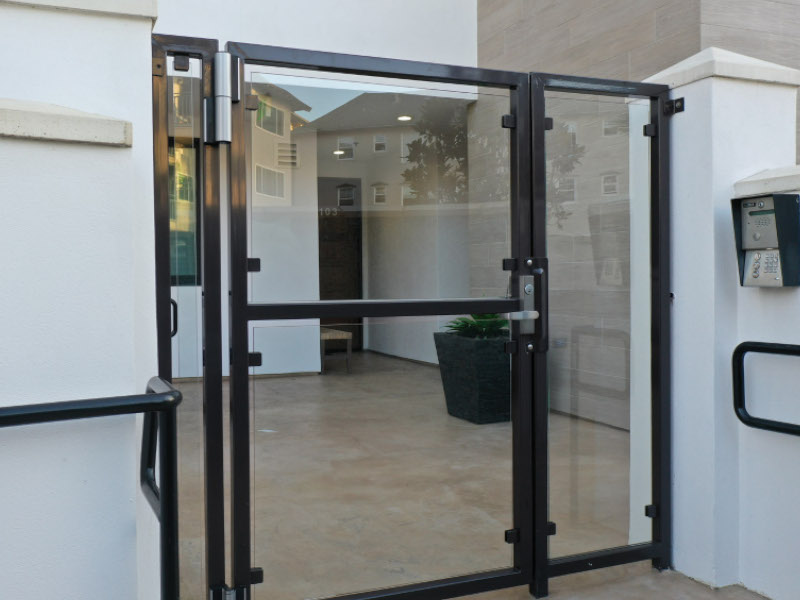
Attractive Entry Gates The most attractive entry gate options offer a modern aesthetic without sacrificing security. Modern gate designs feature geometric shapes, sleek lines and muted finishes. Stylistically modern gates range from upscale farmhouse gates to contemporary minimalist entry gate options. Whether you are looking to build a large entry gate or a simple wooden courtyard entry gate here are some installation ideas and an overview on today’s evolving number of gate styles: -What’s the best way to mount a new gate? What if I have existing posts, walls, or columns?- An existing and/or older home may have pre-existing structural supports and an existing access gate option which is no longer desirable. Old fencing or walls may need to be removed or updated with more modern veneer, stucco, or finish options that combine with a new modern gate design. Entryway remodeling utilizing a driveway gate is an easy way to transform an existing entrance and remove years from the curb appeal of an older home. Access and courtyard gates are often a design element making the first impression when guests arrive. Older bricks or pavers can be removed and replaced in order to set newer and sleeker steel support posts for a new gate. Wooden or rod iron gates with modern elements can add interest and update existing block and stucco walls. Stucco can be painted a new color and new jambs can be plumbed and set to true an old opening. Gate Materials and Design Styles An endless number of style options exist for new gates . Combining materials and styles is also a popular way to update and add an entry gate. Contemporary and/or Modern Gates- Steel or Aluminum frames, ss cable, glass, stainless rods. Minimal and sophisticated. Rustic Gates- Wood and iron with detailing. More natural finishes. Often arched and warm/welcoming. Modern Farmhouse Gates- Combine elements and materials. Simple and sturdy, slats, hybrid steel/wood, barn door styles. Transparency or Privacy? Solid gate designs are more often utilized for private courtyards and patio settings. Cable, rod, or glass panels can be added to solid gate designs for a peek of light and visibility. Entry gates can be transparent or hybrid as well by utilizing a 2/3 body 1/3 window gate design for visibility and security. Full transparency can be achieved by full cable or glass gates, rods, pipes or even slats when spaced appropriately. Professional Gate Installation Automated gates require precise installation to function properly. In addition, entry gates can be heavy and risk damage during installation. Hiring a professional gate installer can be a worthwhile investment and offer a resource for future maintenance possibilities that may arise. Our company offers both sales and preferred installation of all of our gate sales in California. We have reputable pro’s available in Southern and Northern CA. Our pro’s are versed in removal/replacement gate installation, automated entry, and even creating custom hardware solutions needed for custom gate designs. Modern gates often require modern building solutions and professionals that specialize in these type of installations. Why Choose S.D.C.R. Gates? We use only the highest quality materials and finishes in our modern gate designs. We offer fast turn around times for pricing, American made products that last. Our preferred installers are some of the best in the business. For out of state customers we offer nationwide shipping of our products including gates to all 50 states. If you are interested in an attractive and durable gate with a modern aesthetic; give us a call or visit the quote request page. QUOTE REQUEST Cable Railing News Modern Gate Designs MavenFebruary 4, 2025 Rustic Modern Railings Rustic Modern Railings MavenJanuary 14, 2025 cable deck railings 2025 Deck Railing Choices MavenDecember 17, 2024 ADU Railings Best Rated Deck Railings MavenDecember 17, 2024 Deck Safety Deck Safety Checklist MavenNovember 25, 2024 Browse More Posts
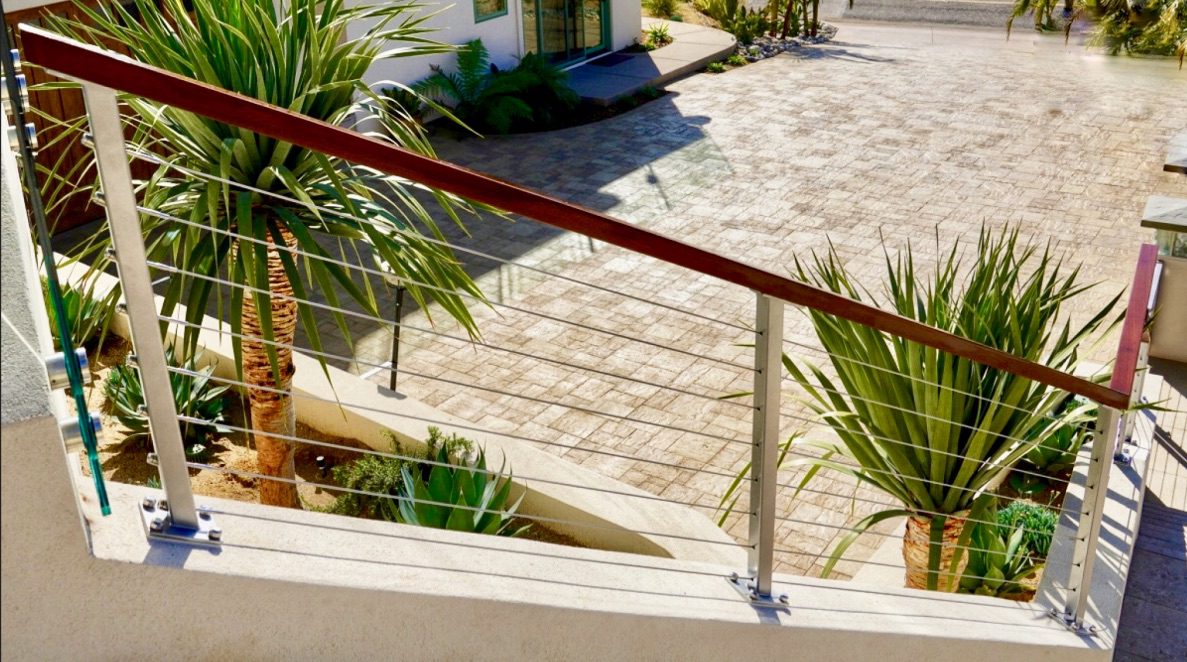
2024 Stair Railing Trends Staircases are often the first element seen upon entering the home yet often overlooked during remodeling scenarios. Great stair railing concepts are what separates a common entry staircase and something more eye catching that will inspire interest for the rest of a design. Modern stairways incorporate important elements into modern design. Building media like glass or polished metal as an element of design can compliment a dark wooden floor or a unique slab table and chandelier. There has never been a better time to build an amazing staircase as modern options abound. Additionally, stair remodeling is relatively low impact and turn around times are faster than bathrooms, kitchens etc. CODE STAIR RAILING HEIGHT IN CALIFORNIA Code considerations will always weigh into a stairway design or remodel. Nobody wants to build a beautiful stairway with elaborate railings to find that the local code isn’t satisfied or the homeowner’s insurance company will not sign off on it. Code stair railing height in most locations is 36″ for a barrier railing section. Additional graspable stair railing sections may be needed and should fall between 34″and 38″. For more info on graspable railings please click HERE. The Most Attractive Stair Railings With code considerations for stair railings out of the way; how do we make them cool? Easy – first off incorporate some of your own style or home style into the railing style. Add modern elements like “floating stairs” , lighting, contrast between colors and textures. Modern iterations of classic designs work well. It’s amazing what a stainless cable railing will do to an old stair set. Tie in some dark wood top rail with hardwood flooring. If budget is a concern as it often is; think about refinish possibilities or repurposing and refinishing existing elements if possible. Cheap vs. Expensive Stairways Custom fabricated railing systems, curves, advanced joinery methods, hand carving, etc. are all terms that will likely relate to a higher cost improvement. Glass railings inside the house are much pricier than picket, rod, or cable options. Floating stairs or mono stringers, spirals, and structurally challenging layouts will drive costs. Open designs like cable are great for narrow stairs. If privacy is desired or stairs open to a living space consider etched glass for a feeling of privacy without losing the aesthetic. What About Exterior Stairs!? Many of the same ideas and code requirements apply to exterior stairways. If you have an awesome deck and amazing views you can draw attention to it and attract use with aesthetics. Light up your stairs with tread lighting or post lighting. Lighted stairways are safer and really cool to look at. –Maximize your space – Open air and light penetrating designs are where it’s at unless you absolutely need privacy or wind breaks. Enlarge the perceived space with light friendly stair railings like cable railings and transparent glass panels. DIY the Stairway or Hire a Pro? Stairways can be tricky but we have products and techniques to make your DIY stair railing project easier. Pre made components, tool less fittings, and pre finished materials make your stair railings from SDCR easier. For Jobs that call for something more; we have specialized preferred contractors that can adapt to any building scenario. Give us a call or visit the QUOTE REQUEST form for a free stair railing estimate today. CLICK HERE TO REQUEST A QUOTE FROM OUR SALES TEAM! Cable Railing News Stair Railing Ideas MavenSeptember 6, 2024 Safe Deck Railings Pony Wall Railing Renovations MavenAugust 20, 2024 kids and cable railings, Safe Deck Railings Safer Deck Railings MavenJuly 31, 2024 deck railing costs Deck Railing Costs MavenJuly 16, 2024 glass railing posts All Purpose Railing Posts MavenJune 30, 2024 Browse More Posts

Code Compliant Clear Spacing Building codes nationwide hold to a 4″ maximum clear spacing requirement when it comes to constructing new or retrofitting older barrier railings. More simply stated; this means that no gap anywhere on the railing should exceed 4″. Older homes, condos, and apartment buildings with outdated railings may need to be upgraded due to this requirement. Being grandfathered in at an older code spacing requirement may not prevent liability due to possible falls or injury caused by outdated spacing requirements. Newer codes and standards for child safety railings require tighter spacing than standards from decades ago. What’s the reason for newer and tighter spacing requirements? The 4″ max spacing requirement used for current codes was actually designed to prevent small children from being able to force their head or body into and through the gap anywhere on the railing framework. It’s been this way for some time now and it really boils down to child safety requirements. In this article we will share some information necessary to upgrade your railing systems and make them safer for children, pets, and people. Code Railing Height by State Railing height considerations can vary by state and it is recommended that anyone considering new railing construction or retrofit check with local building codes prior to installation. In California, a minimum railing height of 42″ is required. Some states still hold to a 36″ railing height requirement. How do I figure out my railing height? Railing height should be measured from the top of the deck surface to the top of the railing cap member. A good rule of thumb is to measure from multiple locations to ensure uniformity across the surface. Decks and patios can vary, especially when dealing with slopes so it’s best to check height in multiple locations. Railing Gaps, Vertical and Horizontal Member Spacing Checking for gaps along the railing framework is a good way to make sure your railings meet current codes. Child safety railings should not contain any gaps larger than 4″ and there are common locations where this may occur: –Vertical Members – check spacing between pickets, balusters, and or vertical pipes, cables for compliance –Horizontal members– bottom rails spaced from deck surface, horizontal pipe or cable spacing. Cable spacing should not exceed 3″ in order to prevent more than 4″ when spread. Solid horizontal members like pipe and/or wooden railing members that do not move can be spaced at 4″ clear –Panels– glass panels or solid wood, steel or other panels should not contain gaps larger than 4″ in between panels Hiring a Professional for Safer Railings Many people choose to hire a deck builder or railing professional to guarantee safety and code compliance. Hiring a licensed contractor that is familiar with local and current code requirements is a good option for higher risk applications like raised decks, balconies, etc. DIY products and solutions are very popular and effective but there are also applications that are better suited for hiring a professional installer. High rise multi unit complexes, HOA’s, and municipalities are often required to use professional contractors for construction projects. Additionally, insurance claims often require the use of a professional. From a railing application standpoint; stairs, angled applications, large scale projects, commercial, and industrial projects are best handled by licensed professionals. Our team at S.D.C.R. has been fabricating and installing child safe, code compliant railings for nearly 2 decades now. If you are interested in learning more please give us a call or visit the quote request page to receive an estimate. ADA Compliant Railings, Architecture test post MSimontonApril 2, 2024 Cable Railing News, kids and cable railings Child Safety Railings MavenMarch 28, 2024 cable railing code, Cable Railing News Height Standards for Deck Railings MavenMarch 5, 2024 Stainless Steel Cable Railings Choosing the Right Stainless Steel Cable Railing for Your Deck Cole RouseJanuary 24, 2024 Stainless Steel Cable Railings Why Stainless Steel Railings Are a Safe and Sleek Design Option Cole RouseJanuary 24, 2024 Browse More Posts
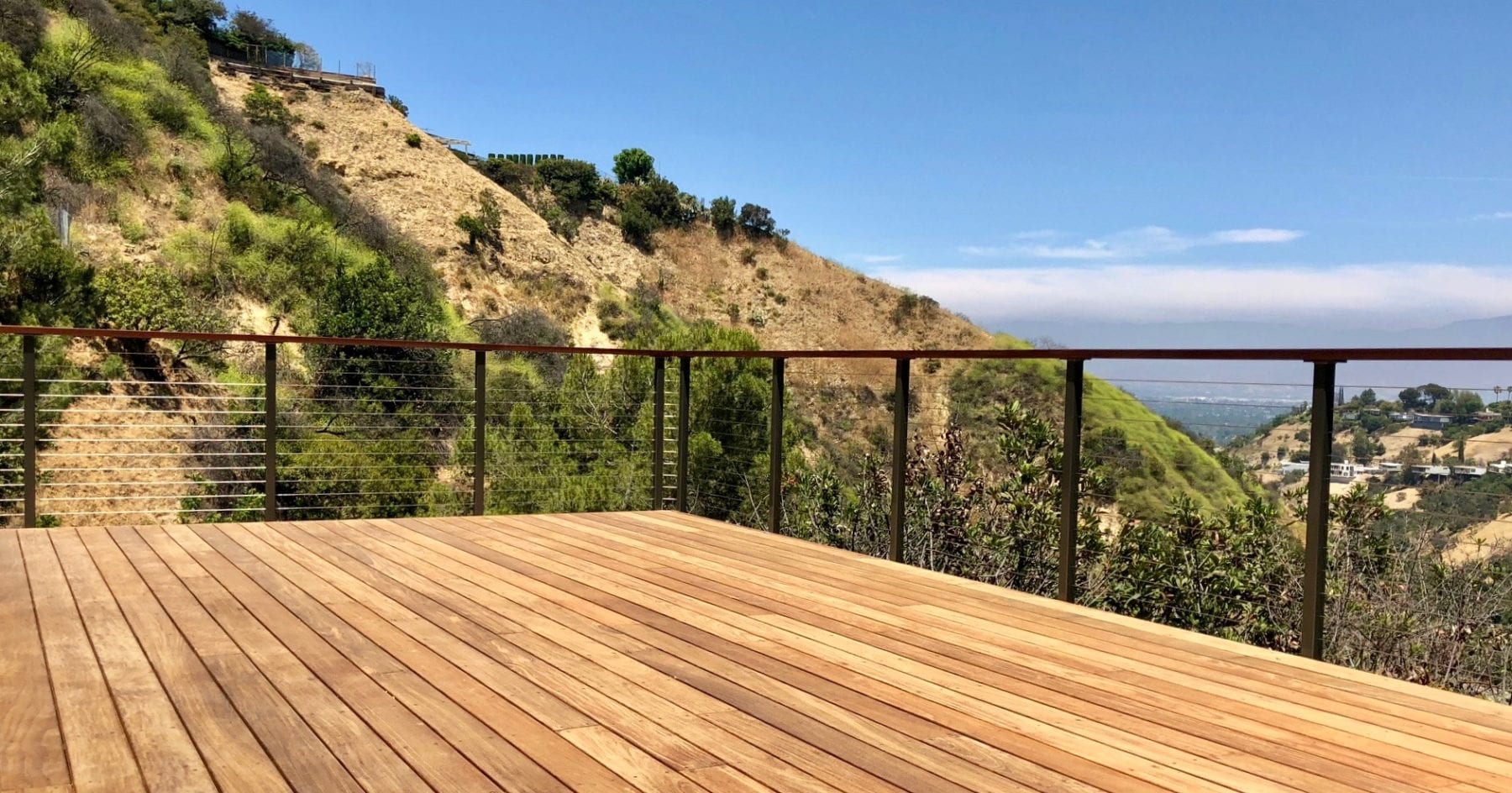
Standards and Code Considerations for Railings on Raised Decks Whether you are building a wooden deck, concrete patio, staircase, or an interior loft; your project will involve the construction of barrier railings. A barrier railing is designed to keep persons and pets safe by providing a “barrier” to prevent falls from a raised surface. Building standards and codes for railings have evolved over the years, mostly becoming more stringent for safer railings. Included in this post are some of the most common considerations for constructing a railing system on a raised deck or patio: Railing Height Code Requirements The majority of states in the U.S. require a minimum barrier railing height of 36″ from the top of the substrate (deck surface) to the top of the railing cap. Commercial projects often require a railing height of 42″ for an added factor of safety. Railings in California whether residential or commercial require a finished railing height of 42″. Stair railings require a minimum barrier height of 36″ and also the additional safety factor of a graspable railing or “grab rail” between 34″- 38″. A top railing can double as a grab railing in certain scenarios; the main consideration here is that the top railing is graspable. A graspable railing must be small enough for even a small hand to wrap the entirety of the member; often this means no larger diameter than 1.5″-2″ and not more than a 6″ perimeter measurement for the rail. Deck and Stair Height Standards for Railing Construction There are standard platform heights for when railings are required to be constructed on raised structures. The most common call out is a 30″ above grade height requirement. A common industry misperception we encounter is that a low level structure does not require a railing; or that a non code compliant railing can be constructed under a certain deck height. Code compliant deck railings are required to be constructed on any surface higher than 30″ from natural grade, including stairs. This is typically referring to natural or native grade; meaning bringing in fill to raise the grade may not satisfy the requirement. Stairs containing more than 3 risers (in some cases any stair set) are required to have railings. Additionally, when constructing railings on any raised surface (even under 30″) or retrofitting existing railings; the new railings are required to be constructed to current codes and building standards. In all cases, we recommend checking your local municipalities. Additionally, we recommend that homeowners understand that building inspectors have ultimate discretion on site if they believe something is substandard or unsafe. Standards and codes are often up to the interpretation of municipalities and their representatives or inspectors. Regulation Height for Porch Railings Construction of porch railings falls under the same regulations and standards that apply to deck railings and stairways. Although porches are often only a few steps high, they are highly trafficked and serve as raised entryways to residential homes. A porch that is at least 30″ above grade will require the same barrier railing standard as a raised deck of this height. Porch stairs should have barrier railings and also graspable railings to accommodate high traffic and often the use of young and elderly people who may pose a higher fall risk. Modern railing systems like cable railings and glass railings are an excellent choice for safety, durability, and a beautiful aesthetic. San Diego Cable Railings offers pre-made railing packages that satisfy height standards for deck railings at 36″ or 42″ requirements. Our railing posts are engineered for safety and longevity with welded connections, durable stainless steel, and heavy duty coatings. Visit the quote request page or give us a call to learn more and build a code compliant railing system for your home today. Quote Request
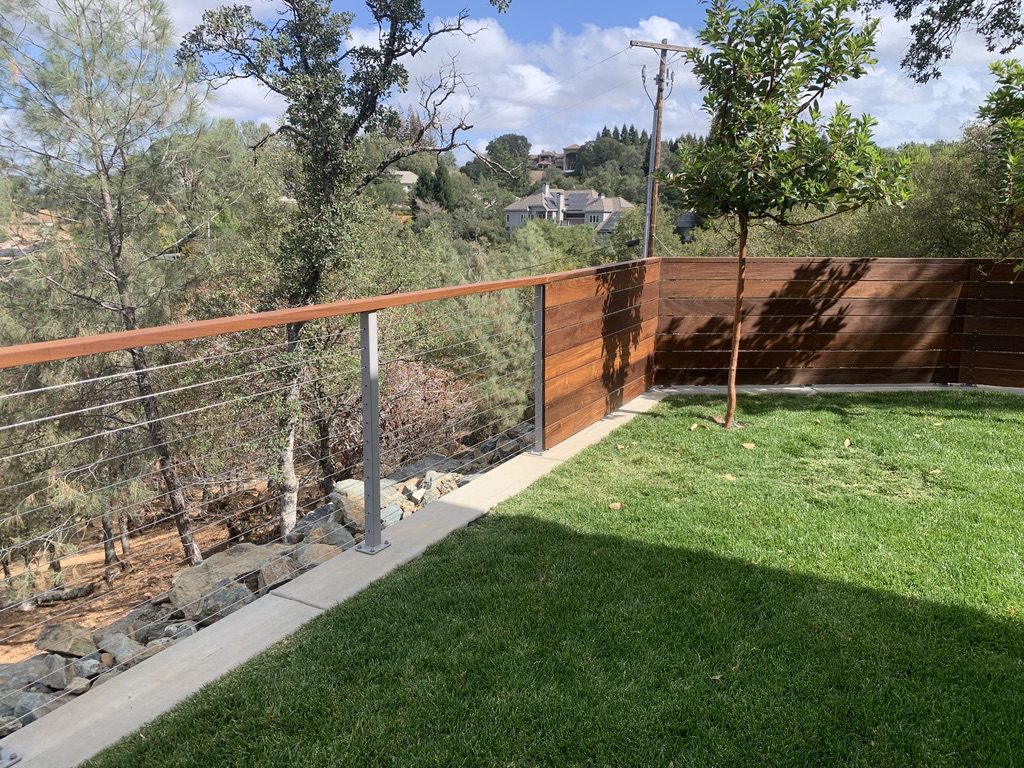
A railing system that mixes and matches components or different building media is referred to as a hybrid railing system. This can be as simple as a steel post cable railing system that utilizes a wooden or composite cap. Another example of hybrid railing would be including multiple types of infill on a single installation. For customers exploring hybrid railing options or wondering about the benefits of installing a “mix and match” type system; here are some examples of how this can benefit your project: Hybrid Material Selection for Cost Effective Deck Railings One of the easiest ways to save money on any remodeling project is by selecting cost effective materials or value engineering the project. Cable railings are some of the easiest systems to modify and hybridize because they are so versatile. By simply selecting a wooden frame to support stainless cable infill, you can create a hybrid design that will cost less than an all steel system. Another example would include the use of a wooden or composite top rail combined with steel posts and cable infill. Similar configurations would also work with glass or pipe infill and utilize cost effective framing to lower the burden on more expensive materials like glass and stainless steel. Selecting wooden graspable rails (grab rails) to combine with steel brackets would provide cost savings in comparison to an all steel graspable railing. Glass Panels and Cable Combination Railing There are several reasons to examine the use and/or combination of glass and cable on a single installation. Cost could be one factor, but the repeated example we encounter is when there is a need for windbreak on a section of deck but not on the entire deck. Glass panels are transparent and beautiful to the eye; they also make an excellent wind break. A customer in the market for the aesthetics of stainless cable that also wants wind protection can choose a hybrid cable/glass system to achieve both goals. The hybrid railing in this case will serve multiple uses, likely cost less than all glass, and be interesting to look at. Both systems provide transparency and beauty, while the cable portion will require less frequent cleaning and cut down cost. Hybrid Railings for Aesthetic Purposes Roughly 50% of our railing kits and installations are now performed on the interior of our customers residences. Homes of all different ages and styles make perfect candidates for hybrid styling. One example could be a home with an existing oak hardwood floor and a customer that is looking to remodel their staircase. By simply fabricating a wooden top rail made from similar oak; a hybrid railing will tie in the old with the new. In this example a solid steel or stainless system may not work with the design and the older flooring but the hybrid railing does a great job marrying the two. The glass with cable combo can also work on the interior sections of homes where a loft will require glass but the staircase will be done in cable. Hybrid combos work great with older homes that do not require ultra modern or contemporary finishes. Design combinations and possibilities are endless with multi purpose railing posts and mix/match infill options like stainless cable and glass. Our company has designed and supplied hybrid railing combos for customers nationwide. If you are interested in obtaining a quote for hybrid railing visit the quote request page today.
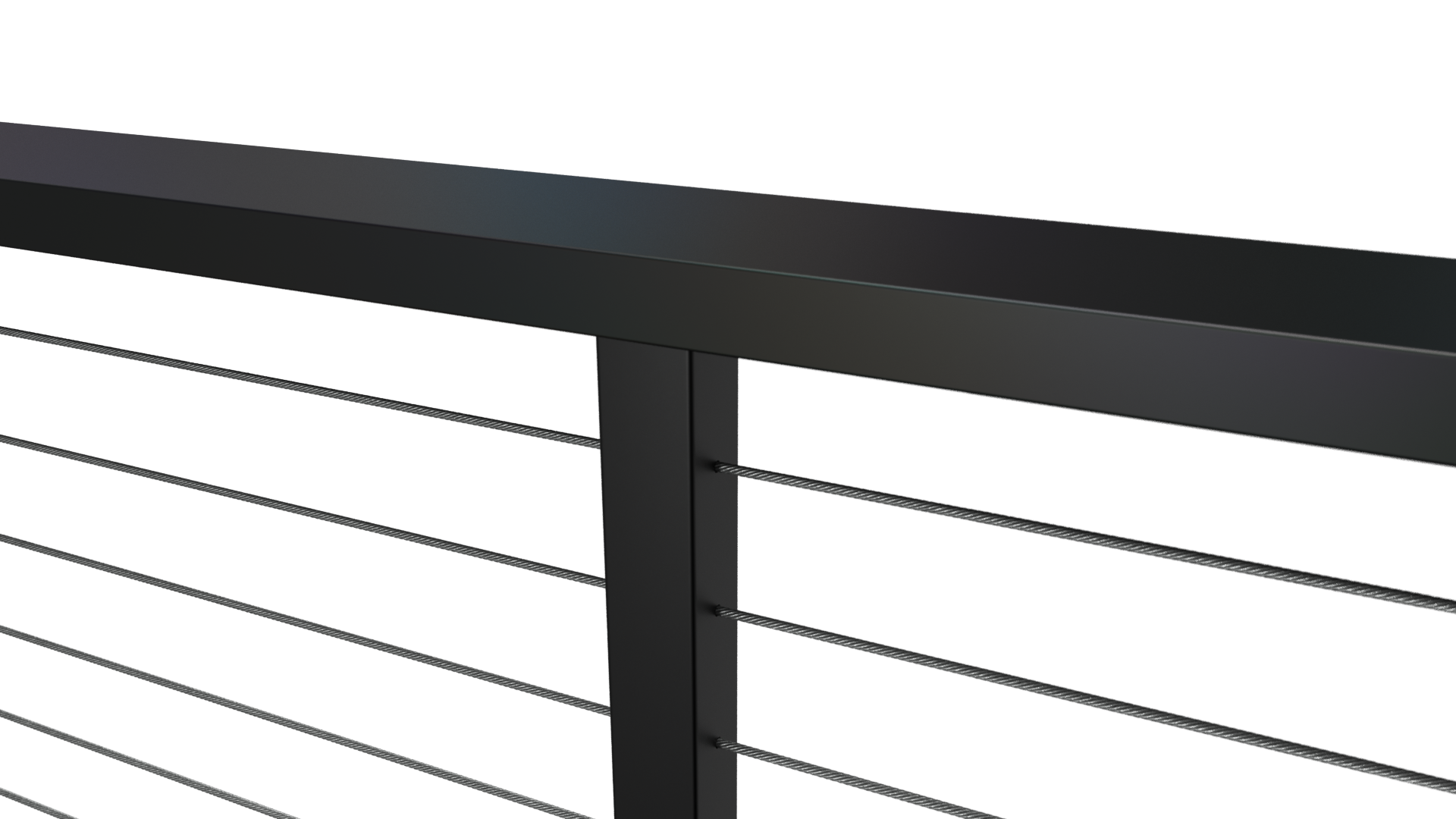
There are several types of interior and exterior railings and railing post types available in today’s marketplace. Reviewing the different mounting types, recommended spacing, materials, colors and applications can be daunting at times. In this post we aim to clarify some of these details and offer some common terminology regarding the most popular railing post types. Most of the reference material is geared towards stainless steel cable and glass railing systems as those make up the majority of our sales and installations. Structural Railing Posts Depending on the type of railing system there may be a single type or many type of posts used to support the infill and top rail. Structural posts refer to those designed to sustain lateral and possibly tension loads within a railing system. An “end post” or a “corner post” within a cable railing system refer to structural railing posts. In comparison, a “spreader post” would not be considered a structural railing post as its purpose is not primarily structural and mainly aesthetic. A common spacing recommendation for structural railing posts is between 4 and 6 feet on center spacing. Cable railings require tighter spacing for structural posts than picket railings due to tension loads and spread. The most common recommendation for cable railing systems is 4′ on center, while glass panels might be 5′ on center, and various picket or rod infill systems can push to the 6′ on center spacing. These are generic guidelines as systems and municipalities vary. Installers should follow recommendations and current codes. Glass Boot and/or Base Shoe Support Systems Although not technically a railing post, base shoes are becoming more and more commonly used for glass railing systems. A “base shoe” or “boot” is secured to the deck surface and acts as a structural clamp and support for heavy duty tempered glass panels. Structurally, a boot system is one of the only secure ways to support glass panels without the use of railing posts. Base shoes are engineered for structural use and support, requiring grout or a special locking system to secure the panels and support system. Recent updates have called out the use of laminated glass more and more often for “no top rail” glass systems. A base shoe mount is a proven way to safely achieve this type of install. Railing posts of different types and sizes can also be used in lieu of base shoe for installing glass panels. Typically glass clips (small clamping mechanism) are attached to structural railing posts in order to secure glass panels for this type of installation. Additionally, there are full framed glass systems which utilize channel and/or full framed glass railing with top and bottom railings and structural posts every 4-5′. Intermediate Posts, Spreader Posts, and Slim Line Railing Posts Intermediate posts like the one photographed above are also called “spreaders” or “line” posts. This type of railing post is often utilized to increase a viewing window without the larger profile of a structural post. As photographed the structural posts are 2″ square while the spreader post is a mere 3/8″ wide profile. The intermediate (spreader) post provides some rigidity and prevents the stainless steel cables from spreading, without the need for the heavy wall or width of a 2″-4″ post. When dealing with cable railings, glass, and other low visibility systems; spread is key to opening the view. When utilizing spreader posts between structural posts, installers can achieve clear windows of 6-7 feet without fear of code compliance or stability issues. Additional Notes on Railing Posts and Terminology Consumers should note that railings and fencing are very different when it comes to spans and spacing. There are many photographs found online that illustrate posts, pegs, clips, and all different kinds of spacing that may or may not satisfy code requirements for a safety railing. Just because photos exist, does not mean it will satisfy an inspection. Windbreaks and fencing may not require the same safety measures as a second story deck. Railings with and without top railing members will often have different rules and code requirements. Our company (San Diego Cable Railings) has been furnishing railing kits to homeowners and builders nationwide since 2009. We furnish a variety of railing posts for cable, glass, rod, and horizontal panel systems. Our welded connections and high grade stainless posts have been engineered to satisfy loading requirements, and even our spreader posts provide unmatched strength and elegance for your home. If you have questions about any of our railing post types or would like to obtain pricing for a railing system, give us a call or visit the quote request form today.
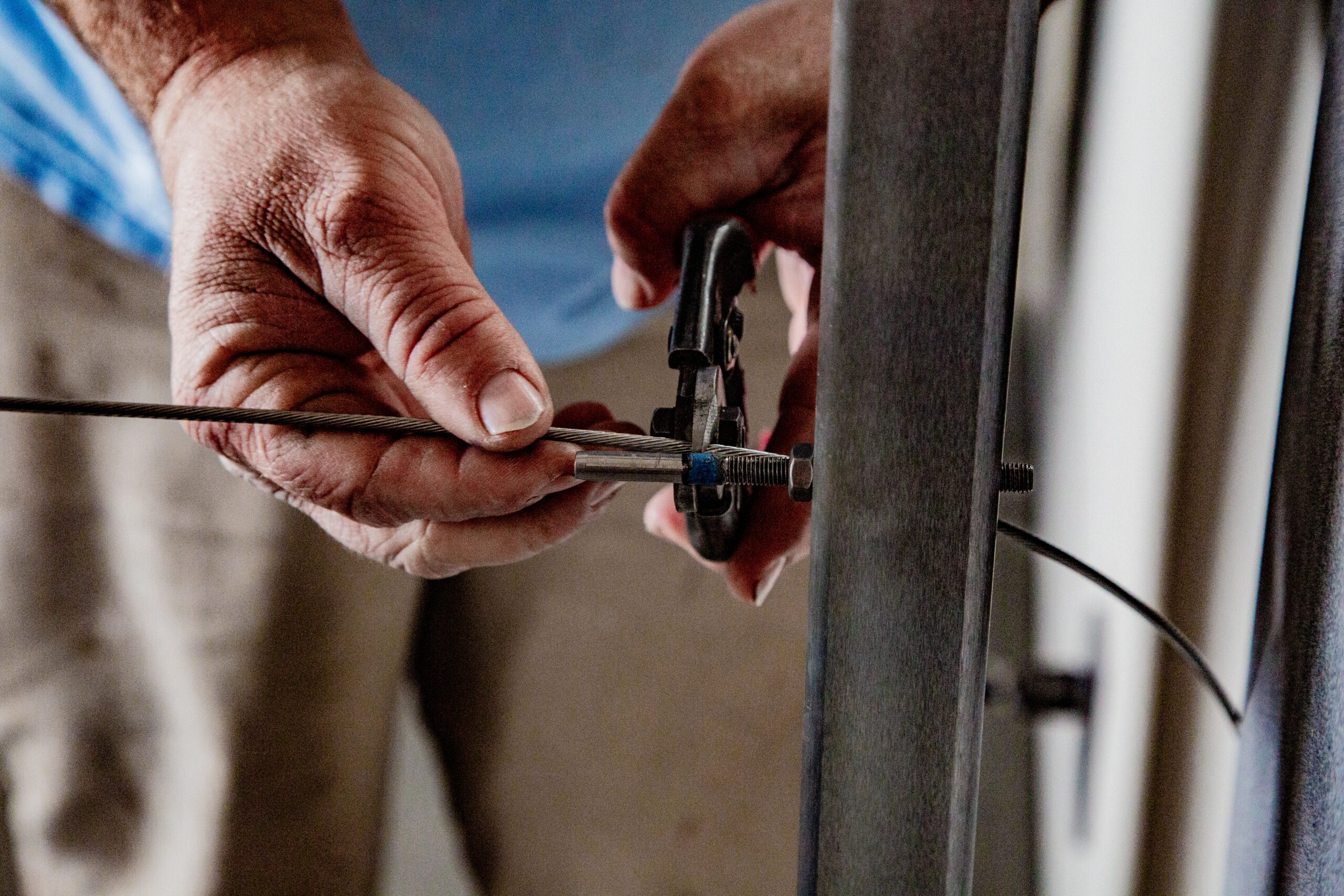
Our company furnishes hundreds of railing systems a year to professional and DIY installers nationwide. The quality and variety of products we produce ensure code compliance and beauty. Cable railings and glass railing systems are a staple for us and have been for many years. These are some of the most popular products purchased for renovations inside and outside the home. Included in this post are some of our most recent projects and brief product and construction descriptions of our San Diego railing installations. Cable Railing Installation at San Diego Yacht Club Cable railing systems are very popular in marine environments because stainless steel is durable and nearly invisible. Our installation at the SD Yacht Club featured marine grade T316 stainless railing posts; with black powder coating for extra durability and aesthetics. Small diameter 1/8″ cable assemblies and Ipe’ hardwood top railings make for a solid and attractive railing system. This project was completed by our preferred installers at SD Independent Construction. Cable Railing at Private Residence in Del Mar, Ca These cable railings and cable gates were installed on top of masonry to protect fall hazards created by light wells. A very cool and functional aesthetic with extra utility created by the gates for serviceability. 2″ square black stainless steel posts and 1×3″ stainless top railings create a minimal railing frame with 1/8″ cable infill. Modern railings like these are perfect for allowing maximum light penetration and preserving an open feel in the space. Frameless Glass Railings- Del Mar, CA A frameless glass railing system with a powder coated base shoe accents these large composite decks in Del Mar, CA. Glass railings like these are transparent and create a nice windbreak for outdoor dining. There are few more minimalist ways to completely secure an outdoor space while maintaining transparency. Laminated glass panels were utilized for safety and security on raised decks and systems without top railings. This project was also completed by our preferred installers. Our company has specialized in fabricating and installing modern railing systems like cable railings and glass systems since 2009. We have a team of preferred railing installers up and down the coast of California and customers in all 50 states. If you have questions about products and railing installation, give us a call or visit the quote request page today.
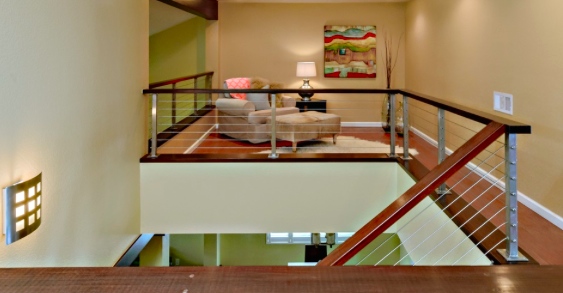
Replacing an existing railing system will remove years from the look of an older home or an existing deck. Many times an aging bannister or patio railing will fall short of current code requirements; it may even be unsafe. In addition to safety requirements, there are aesthetic considerations and benefits to adding new railings. if you are looking to update or modernize an interior or exterior space, modern railings like glass and cable railings can improve light penetration an offer a valuable facelift. Updated fences and railings increase curb appeal, and provide safety and security for your family. Spaces will often appear larger and the home will appear newer after a remodeling project. Here are some things to consider if you are planning a railing renovation: Structural Railing Considerations Railing remodels that include installation of new railing frames require adequate structural backing. An interior floor or exterior deck may or may not have the recommended thickness of structural members to achieve a solid connection. The time to investigate and retrofit is during demolition or removal of the old railing system. A plywood floor or decking plank is not usually suitable for post mounting without backing. Aim to achieve a minimum of 3″ structural wood members or 4″ of concrete thickness to properly attach new railing posts. Select the post mounting type (fascia mount, deck mount) that will give you the strongest connection. Consider custom post mounts for difficult existing conditions that cannot be retrofitted. Removal of an existing pony wall in order to replace it with modern railings is a growing trend and an excellent way to update your interior stairs. This type of railing renovation will usually require a contractor to perform and also consideration of the following questions : Does the existing wall contain electrical outlets or wires that must be relocated? Will there be flooring or wall repairs needed after the removal? Does a new wall cap need to be installed prior to the new railing system? Is additional structural backing needed prior to the new wall cap, flooring, or railing system? In our experience these have been the most common considerations when dealing with existing pony walls on barrier and stair runs in older homes. Our products are perfect for these situations, and our preferred installers have done hundreds of interior and exterior retrofit railing projects. Railing Revovation for an Older Deck or Patio Older decks that are still structurally sound can be great opportunities for renovation and remodeling. Sometimes the existing railings on an older deck are unsightly or do not meet current code requirements. Other times a deck will require repair or retrofitting prior to any installation of new railings. A deck inspection is a pretty straightforward and inexpensive way to examine your options and conclude what is necessary for your deck prior to any renovation. The deck photographed below was in need of repair in the form of swapping out structural members and adding backing at the post locations. Primarily this was due to the age of the deck and use of non treated framing. The deck framing was retrofitted, blocking was added to the perimeter, and a new base shoe glass railing was installed. Exposed members, entry points or minor damage was repaired and waterproofed to prevent further entry. Joist jackets were installed to prevent water intrusion from screw holes and penetrations made for the new decking and railings. The after photo of this set showcases the beauty and modern look of new Trex decking and glass railings. A high quality railing system by San Diego Cable Railings will provide beauty and value for your home. Our products have been field tested for nearly two decades in 50 states. Preferred installation by our licensed contractors is available in most of California. If you are exploring a railing renovation project or interested in our products give us a call at (888) 389-0003 or visit the quote request page today.
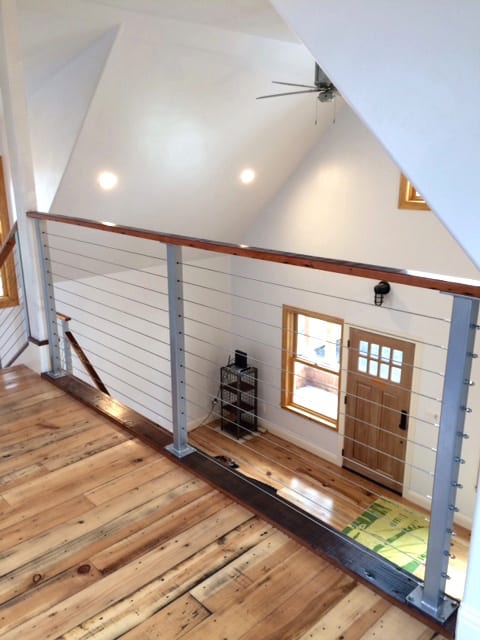
Residential railing projects will often involve wall mounted applications both inside and outside the home. Pony walls, retaining walls, parapet walls, and interior partition walls are often used as mounting points for railing frames. A modern railing system can be a sturdy and attractive way to dress up an existing wall. Cutting down or lowering the height of an existing wall while adding railings is also a very popular remodeling choice. Here are some of our favorite wall mounted railing applications for commercial and residential railing projects: Wall Mounted Stair Railings A large percentage of interior and exterior stairways include short pony walls that require railings and/or handrails. Older track homes will often feature walls like this as the sole means of a fall barrier. While a wall is an effective fall barrier, it might not be the most attractive option. Many of our customers choose to cut down or completely remove these walls in order to open up and modernize their homes. Wall top railings are easy to install with pre-made surface mounted railing posts and DIY cable hardware. Custom glass panels, vertical cable, and horizontal rods are also popular choices for modern stair railings. Parapet Wall Railing Installations Rooftop decks and balconies often utilize parapet walls for structural and drainage reasons. Frameless glass “boot” systems or “base shoe” glass railings are a popular choice for these applications. Waterproofing and protecting perforations is a must when performing parapet wall railing installations. Additionally, we recommend the use of T316 marine grade stainless steel on all coastal applications. San Diego Cable Railings offers a full line of stainless steel glass railing posts, clips and hardware. Ultra transparent tempered glass panels and high quality hardware make these an extremely safe railing choice for parapet wall mounted railings. Best Railings for Retaining Walls Retaining walls and masonry fencing are commonly used for residential barriers on the exterior of the home. They can also be used to retain dirt and support patio slabs when a raised concrete or tile patio is desired (photo above). Mounting a railing system to a retaining wall is possibly the sturdiest way to make a railing connection. Properly designed wall mounted railings basically feel like a block wall. Steel posts with welded base plates are a great option for mounting to a retaining wall railing or fence. Epoxied rods or masonry wedge anchors are used to secure the posts to the wall. Stainless steel cable or glass panels can be utilized for infill as a safe and attractive option for retaining walls. Mounting a Handrail to a Wall Commercial and residential stairways often require grab rails or “graspable railings” in order to meet code requirements. In many of these situations there is a wall on both sides of the stairs (photo above). The solid wall is used to mount the grab rail with mounting brackets and the opposing wall is used to mount the barrier railings with infill. The photo above illustrates a beautiful stainless railing system installed in an industrial complex in San Diego, CA.
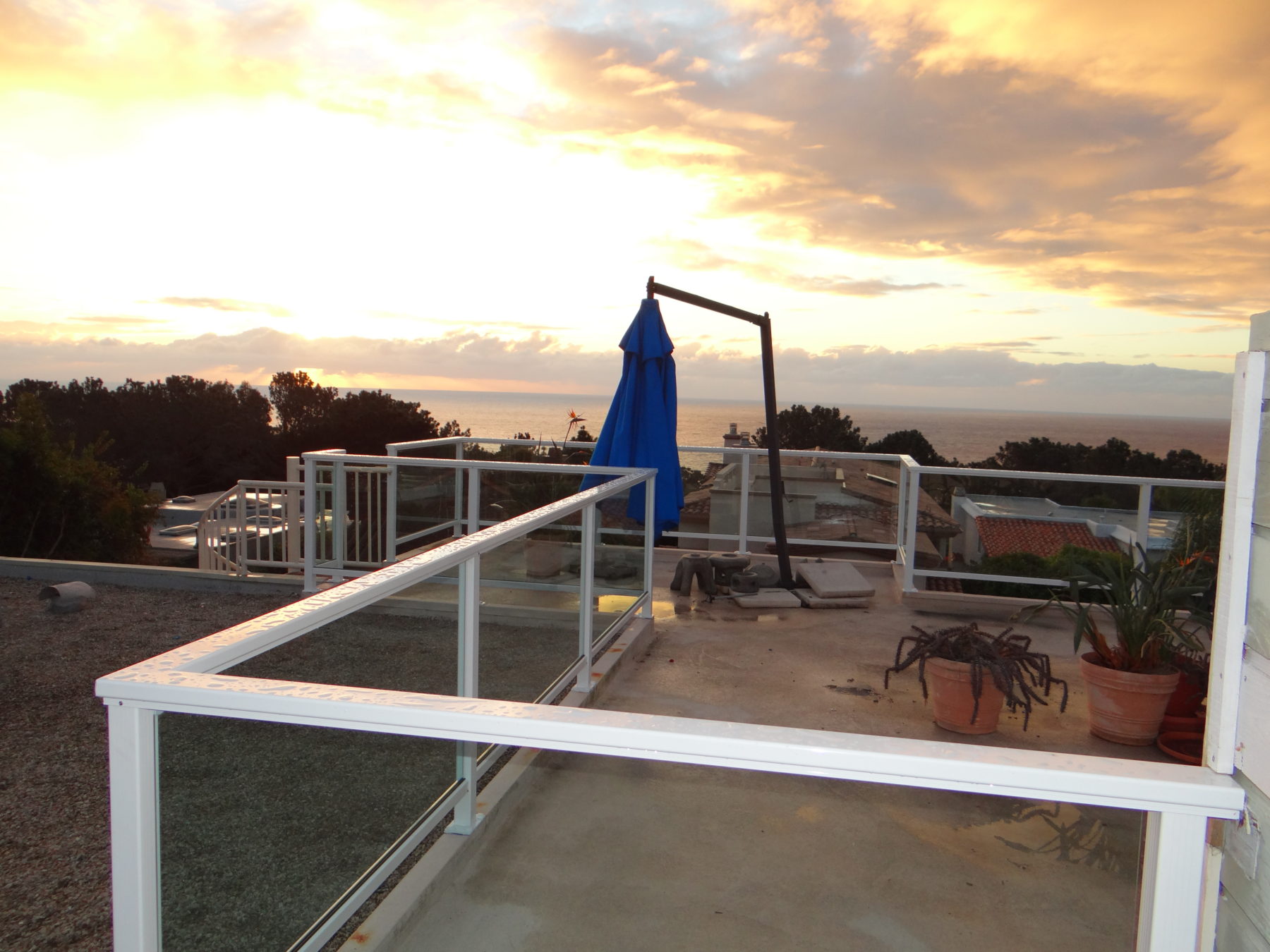
Rooftop decks showcase panoramic views and enhance outdoor living spaces. They add ambiance to our homes and provide opportunities to dine outside. Many times a rooftop veranda will expose views not previously available from inside the home. The extreme heights above grade that enable the spectacular views do require additional safety considerations. When dealing with rooftop deck safety, our concern is often largely geared towards the barrier railings. Barrier railing installations on roof decks pose a different set of considerations than ground level decks. In this article we will discuss some of these considerations and ways to mitigate any potential safety issues. Safest Railings for Raised Decks Whether you choose a traditional picket railing, glass panels, or one of the many other options available; a rooftop railing installation will be unique. Rooftop decks are almost always sloped and sloped deck railings require some custom considerations. So what are the most important things to consider when it comes to constructing rooftop deck railings? How should you mount your railings to a rooftop? Here are some common safety considerations for rooftop decks: Slopes and Transitions- Almost all roof decks are pitched in one or multiple directions. The ability to shed water is what basically defines a dry deck space. The amount of slope the deck requires will depend on the design parameters and the size of the deck. Some rooftop decks on flat roofs utilize drains or scuppers to direct water. In comparison; ground level decks are typically built level, which can be a much easier railing installation. Rooftop deck railings often require the installer to adjust for slope and angles. Choosing to construct a sloped railing vs. a level railing is often overlooked. It can make all the difference in the finished product. Although a sloped railing is a possibility or even necessity in some cases, the level rail option is almost always preferred over a sloped railing. In our experience the sight line usually starts high and moves downward, meaning the top rail will catch the first glance almost 100% of the time. What Can Be Done About Perforations? Rooftop deck safety also includes waterproofing. In most cases, waterproofing should be completed and cured prior to the railing installation. Unless the post bases are to be coated over during waterproofing; it is preferable to install them on a finished surface. Additionally, products like Jiffy Seal and other flashing options can be used under railing posts to protect waterproof membranes. Sealing around post bases and annual safety inspections can also be very beneficial. Structural Considerations for Safe Deck Railings- The safest deck railings are attached extremely well and protect persons and pets from falls. Attachment needs to be done by utilizing connections to structural members. Bolting into plywood sheeting alone is not acceptable, even if a deck is already constructed. Whether you are building a new deck or repairing an old deck, it’s important to add blocking at the post locations prior to waterproofing. A professional railing installer or contractor should be able to locate structural members and or isolate any issues with attachment prior to construction. Solid blocking or structural members must offer at least 3″ of embedment for bolts attaching railing frames. If you have questions about rooftop deck safety or would like an estimate for a deck railing give our pros a call at 844-277-7327 or visit the quote request page.